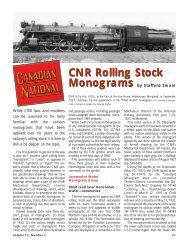CN LINES V12N3 - Canadian National Railways Historical Association
CN LINES V12N3 - Canadian National Railways Historical Association
CN LINES V12N3 - Canadian National Railways Historical Association
You also want an ePaper? Increase the reach of your titles
YUMPU automatically turns print PDFs into web optimized ePapers that Google loves.
A Bridge on the<br />
Bodo Subdivision<br />
by Leslie S. Kozma<br />
A<br />
few years ago my good friend<br />
Shawn Smith showed me three<br />
slides of a bridge and a train on<br />
the Bodo Subdivision. Bill Johnston had<br />
lent these to the <strong>Canadian</strong> Northern Society<br />
archives. I requested copies and<br />
recently came across them again while<br />
catching up with my filing. I couldn’t put<br />
them down. Having had the opportunity<br />
to follow and photograph trains on this<br />
subdivision, I knew the line well. These<br />
images had a story to tell and it became<br />
imperative that these images be shared.<br />
Mr. Johnston kindly agreed. Indeed, he<br />
then revealed that when he took these<br />
images, he was working for the <strong>CN</strong>R as a<br />
student civil engineer on the local line<br />
diversion and related fill project that<br />
replaced this bridge.<br />
A Capsule History<br />
of the Bodo Subdivision<br />
The Bodo Subdivision in west-central<br />
Saskatchewan was an obscure prairie<br />
branch line. Nevertheless, lines such as this<br />
were essential when they were constructed.<br />
It is perhaps difficult to understand in<br />
today’s context, but most prairie branch<br />
lines were built to serve the agricultural<br />
above: By the mid-1950s, trucks, busses and private automobiles using publicly funded<br />
roadways had eroded the railway’s traffic base on most prairie branch lines. This was<br />
certainly reflected in the latter-day passenger services on the Bodo Subdivision; but they<br />
were never great to begin with. Since the spring of 1940, the Bodo Sub was blessed with<br />
but a single Mixed train per week! Train No. 311 left Unity at 14:30 on Fridays,<br />
scheduled to complete the 51.5-mile trip to Bodo at 18:55. No. 312 returned from Bodo<br />
on Saturday morning, arriving at Unity at 09:15. Presumably, the train ran as an Extra in<br />
both directions between Unity and Biggar. Mixed train service on the Bodo Subdivision<br />
was abolished with the issuance of the 30 September 1956 time card. Regardless, this<br />
service continued on an unscheduled basis. Here, the Mixed Extra is being pulled at<br />
Mileage 1.7 of the Bodo Sub by newly minted SW1200RS No. 1214, delivered early in<br />
1956 as No. 1585. The carbody-mounted handrails are evident in this August 1957<br />
view, but the <strong>CN</strong>R’s distinctive spark arrestors have yet to be installed. The <strong>CN</strong>R, still in<br />
the throes of dieselization, was allocating single units to branchline runs, much the same<br />
way as steam engines had been assigned.—Bill Johnston photo<br />
Volume 12, Number 3 5



